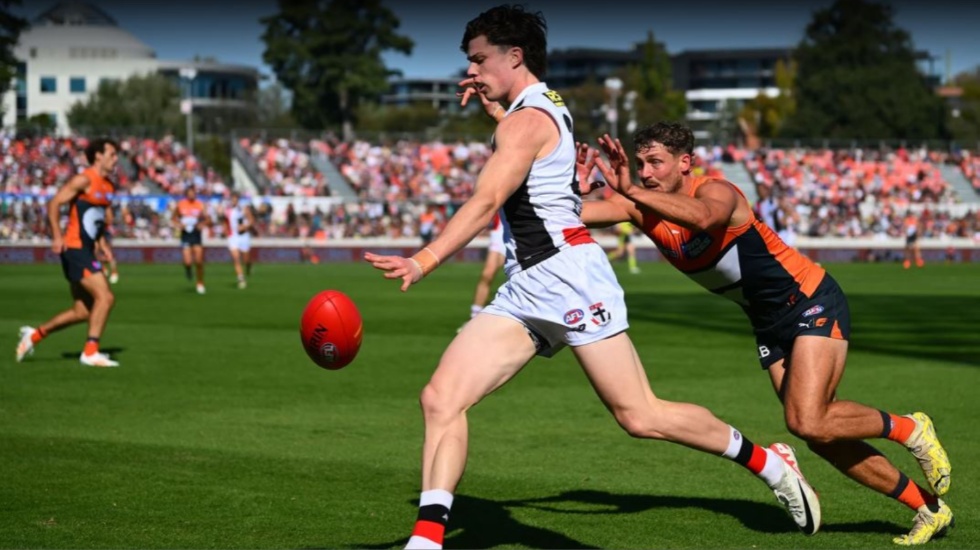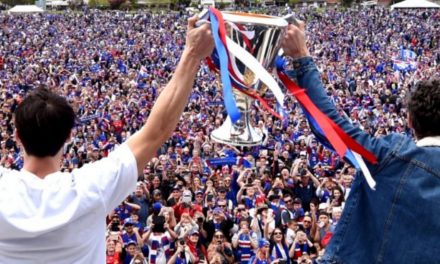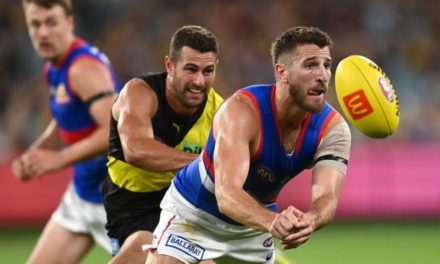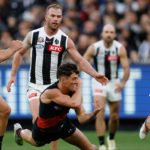St Kilda’s Darcy Wilson gets his kick away against GWS at Canberra’s Manuka Oval last Saturday. Photo: GETTY IMAGES.
With the Tasmania Devils now officially the AFL’s 19th team, there’s plenty of debate about the prospect of a 20th side, and where it should come from.
There’s talk of Darwin, Cairns (even both as a northern Australia team), a third team from either Western Australia or South Australia, with SANFL club Norwood already mooted, plus some left-field suggestions like Newcastle, or the Central Coast or Sunshine Coast.
But apart from a Darwin or Northern Territory team (a sentimental favourite among fans) the next favourite is Canberra. How feasible is this? Let’s take a closer look.
Historical background
Canberra was traditionally an Aussie Rules town, especially as the many public servants who transferred from Melbourne to Canberra took their favourite code of football with them.
In addition, Aussie rules was traditionally played in Southern NSW, the Riverina and in Broken Hill. But this all changed when the VFL moved the Swans from South Melbourne to Sydney and the NSW Rugby League created the Canberra Raiders in the nation’s capital.
The “Green Machine” led by rugby league legend Mal Meninga was successful and gained a popular following both locally and nationally. They were followed by another successful combination, the ACT Brumbies, when Rugby Union went professional.
For a while under master coach Rod Macqueen, the Brumbies were considered “Australia’s team” (a bit like the Dallas Cowboys claimed to be “America’s team) and the Brumbies supplied many great Wallabies. There was once also a soccer team, the Canberra Cosmos, in the now defunct NSL.
Nevertheless, the Aussie Rules flame is still alive in Canberra, and there are regular AFL matches played there. Could they support a whole team of their own? There’s a few things in Canberra’s favour.
For a start, Canberra has (on latest figures) 466,566 people, nearly twice the population of Hobart on 253,654 and over three times that of Darwin.
The very active “CanberraAFLTeam” X (formerly Twitter) account points out that Canberra has a large centralised population that is easily able to get to games at Manuka Oval and would also be the team for southern NSW, adding 400,000 more to the potential fan base, plus the Riverina area and Broken Hill.
Secondly, in terms of the economics, Canberra is an affluent market. The ACT economy is 26.2 per cent larger than Tasmania’s and 75.3 per cent larger than the NT’s. Canberra residents have the highest disposable income in the country and the highest median income. Canberrans have more money for tickets and merchandise. Collectively, Canberrans have 2.5 times as much disposable income as Hobartians, and 6.5 times as much as people who live in Darwin.
Thirdly, in terms of television rights, the biggest selling point for a Canberra team is the value added as a 20th team. Any 20th team will avoid a bye, but a Canberra team is also a reasonable choice as a TV market, which will also help pay for Tasmanian expansion.
According to Regional TAM, the Canberra TV market is 566,000 compared to the entire Tasmanian TV market of 534,000, with the NT population too small to be included as a separate category in the data.
A 20th team means an extra game every round and greater broadcast rights to help pay for expansion. As a NT team would run at an estimated $15 million loss, Canberra would be a stable option to complement Tasmania’s bid.
In terms of talent, Canberra has its share of big names in the AFL, such as Alex Jesaulenko, James Hird, Don Pyke, Craig Bolton and currently, Harry Himmelberg, Tom Green and Jack Steele.
But according to James Coventry’s fine book “Footballistics”, the ACT only produces 17.1 AFL players per million people, which is above Queensland and NSW, but well below NT (56.9) Tasmania (48.0), WA (45.0) and the other heartland footy states SA and Victoria.
In terms of fans, Google Trends Search for AFL news has the ACT is in sixth place, ahead of Queensland and NSW, but well behind Tasmania (in first place), SA, Victoria, WA and NT. On nearly all the metrics, Canberra is clearly a mixed code town, not as into AFL as Tasmania and the mainland footy states and NT, but usually well above NSW and Queensland.
The Giant in the room: GWS
In terms of population, economics, talent and fans, Canberra is a reasonably consistent performer, but is it sufficient to justify a stand-alone team?
To assess this, we really need to address the Giant in the room – The Greater Western Sydney Giants. GWS has invested strongly in the Canberra market, with three AFL games a year, an academy and a commensurate commitment to AFLW in the ACT.
PLEASE HELP US CONTINUE TO THRIVE BY BECOMING AN OFFICIAL FOOTYOLOGY PATRON. JUST CLICK THIS LINK.
Does the AFL want to throw all that hard work away with a new venture? On the other hand, would this be considered a “sunk cost” if the AFL decided it wanted a full-time Canberra team?
GWS does annually gets $2.3 million from the ACT government, of which half, $1.15 million, is a partnership fee to help develop the GWS brand in the ACT through the academy.
Some locals believe this is a pretty good deal for Canberra as they get three AFL men’s games, one pre-season game, an AFLW game, and a prominent advertising spot on the guernsey (above the number), which is much cheaper than what Cairns pays for a single AFL game or what Mackay pays for AFLW.
And it is a good deal compared to what the Tasmanian government paid for North Melbourne to play in Hobart and Hawthorn in Launceston (now to be phased out with the entry of the Tasmania Devils into the competition).
Similarly, that ACT Government funding for GWS would just transfer to the Canberra team like the Tasmanian government transfer of funds from Hawthorn and North Melbourne to the Devils.
This question is whether GWS will struggle to please two sets of fans, and also creating a perception that the Giants could not survive without Canberra. The Canberra games may also reduce incentive for GWS to put more energy into western Sydney.
Finally, there is the Manuka question. Manuka Oval is centrally located among pubs and restaurants, and will be along the light rail by 2033. Cricket ACT wants a Big Bash League team and is already pushing for an upgrade to 20,000 capacity by the time the Giants’ current contract is up. This is notwithstanding some calls in Canberra for a new stadium that could accommodate all the major local sporting codes.
Conclusion – a capital idea or capital punishment?
So the AFL faces a bit of dilemma with a 20th team, if there is to be one. A third WA team would bring in the money, but is there a need for another team in Perth? Darwin is the sentimental favourite, but would it cost too much to have a team in the top end?
Canberra seems the compromise candidate. Enough of a population to work, and a “mixed market” for football codes right on the “Barassi Line”. It wouldn’t be going into territory that is unfamiliar with Aussie Rules, or even hostile to it.
Nor would it be going into an overcrowded heartland like Victoria, SA or WA. There is enough of an Aussie Rules community to support the side, but also room to grow. But the AFL would have to make a decision regarding GWS and Canberra. Some say it would give GWS a chance to really go after the western Sydney market without being distracted by its second “home”.
In some ways, it’s fitting that Canberra is the compromise candidate for the AFL, as it was the compromise Australian capital city, between Sydney and Melbourne but not too close to either. Let’s see if the AFL is in the mood for a bold vision with risk, a safe bet or a compromise.
Professor Tim Harcourt is industry professor and chief economist at the Centre for Sport, Business and Society (CSBS), University of Technology Sydney. Tim also hosts Footynomics – The Economics of Sport www.footynomics.com.au












Canberra makes the most sense, the only other feasible option is w.a3.
I laugh at people that suggest n.t, it would be a disaster on and off the field and a financial black hole. The population couldn’t support a baseball team, let alone a team in the biggest sport in the country.
To the poster above the giants would just play those 3 games at Blacktown or Henson park, which would be better for their growth in Sydney anyway.
This is a great article! I have lived in Canberra all my life, have been a mad Bombers supporter from the time Teddy Fordham kicked 7 in the ’65 GF. I played junior and some senior football here when I was younger. Back in the day “Aussie Rules” was the number 1 code in Canberra. And by a long way! As the Commonwealth Government moved the major departments to Canberra, the majority from Melbourne, along came with that move heavy supporters of various VFL teams at the time.
A fellow by the name of Ron Cahill, Canberra’s senior magistrate at the time and a one eyed Collingwood supporter (unfortunately) as well, was instrumental in lobbying the VFL (AFL) at the time with a committee of local enthusiasts to establish a team in Canberra then.
It was not to be, and the ARL and ARU both jumped in front and set up respective teams to the detriment of our football code.
When in the late 80’s and early 90’s the Canberra Raiders started winning and a short time later the Brumbies started to shine, it drew the younger fans away from football to support heroes in those codes.
Nevertheless that market can be rebuilt with a solid support base still here. After all its the best sport in the world!
And southern NSW who use Canberra as their large regional centre would garner support for their “local” team.
As the article mentions we have a high disposable income across the city and surrounds to make the game pay here.
There is talk presently about a new Canberra stadium for the rectangular codes. Why not make it a circular field to cover everything?
Manuka Oval is a perfect inner city location and if Tassie can get a grant for a new stadium perhaps the cost would be cheaper for us to redevelopment Manuka with a roof to cover and keep the frost off in cold winter night games.It could be shared by all codes with the right organisation of games.
Hopefully the benefits of a team here will be considered by the AFL.
An interesting article, but it omits or overlooks one of the reasons the Giants play home games in Canberra – the Royal Easter Show prevents them playing at the Showgrounds (aka Giants Stadium / Engie Stadium) around Easter every year. And I write that as a Giants Foundation Member who is still a member and regularly attends matches in Canberra and Sydney.
Should the Giants withdraw or be excluded from the ACT, where will they play those games in March or April?